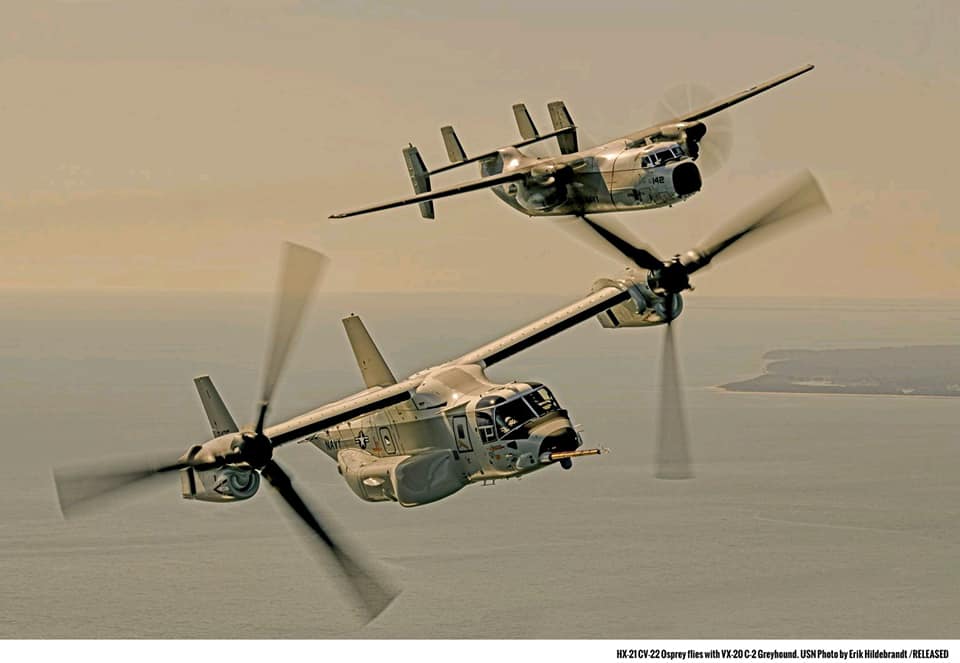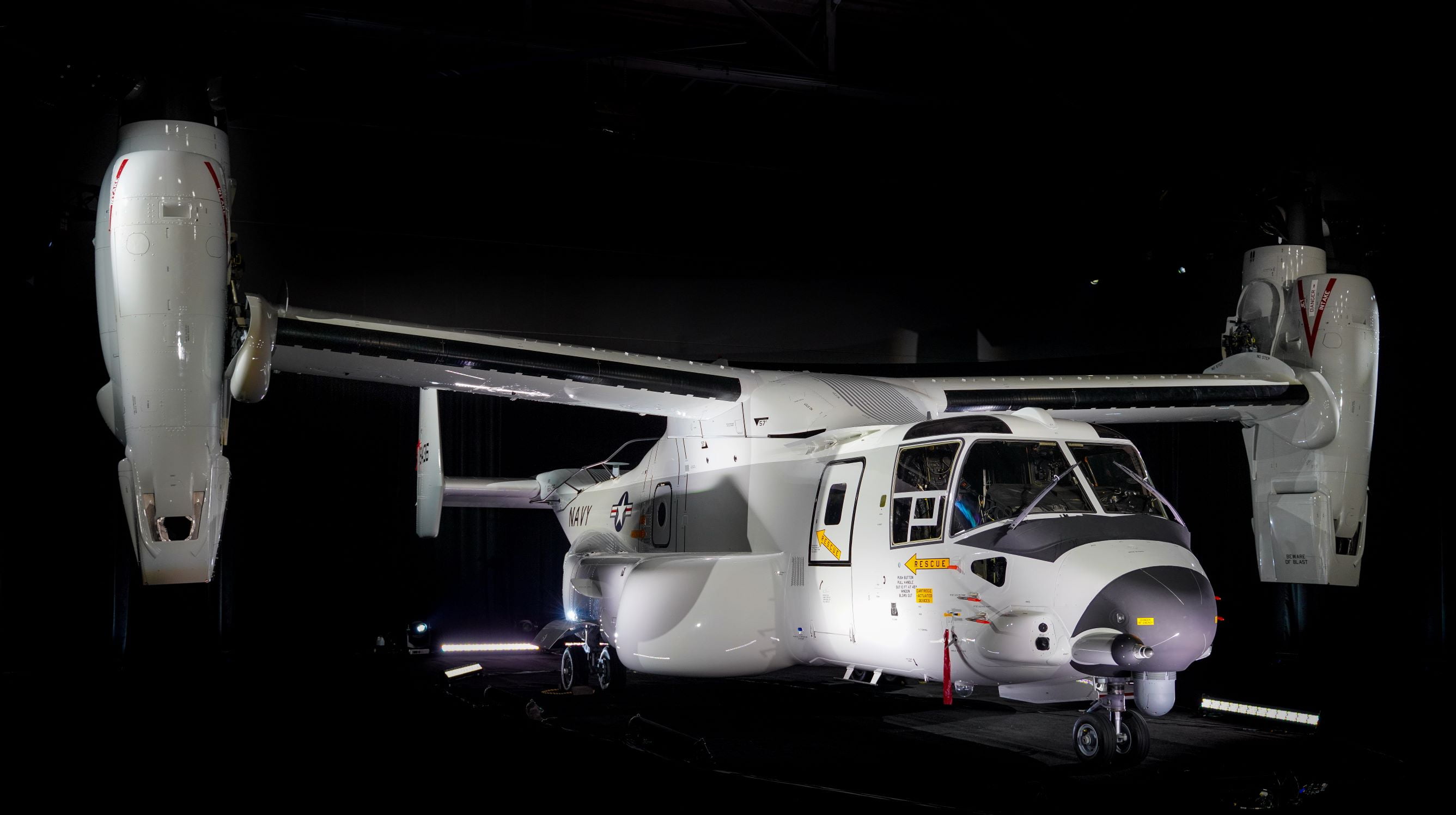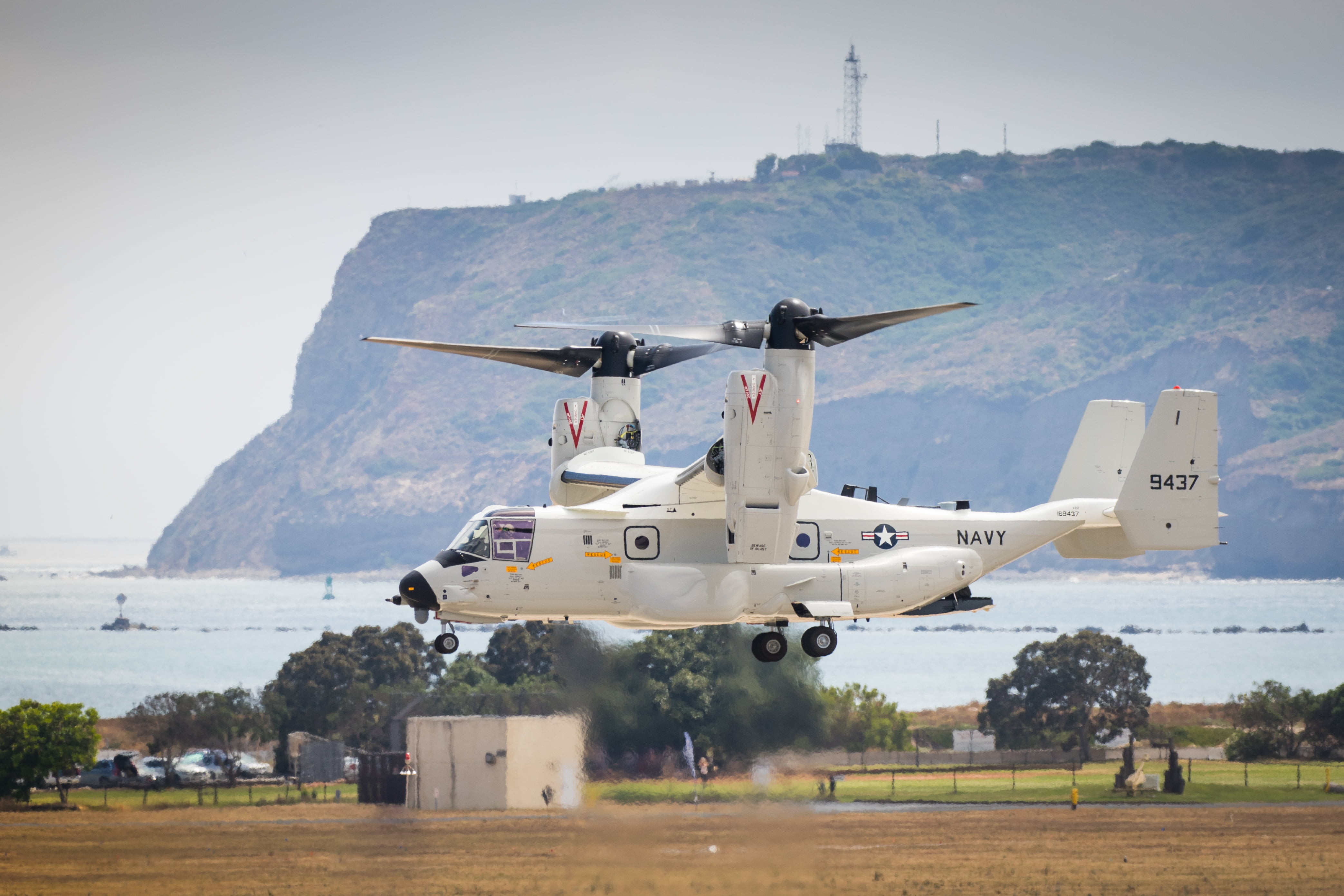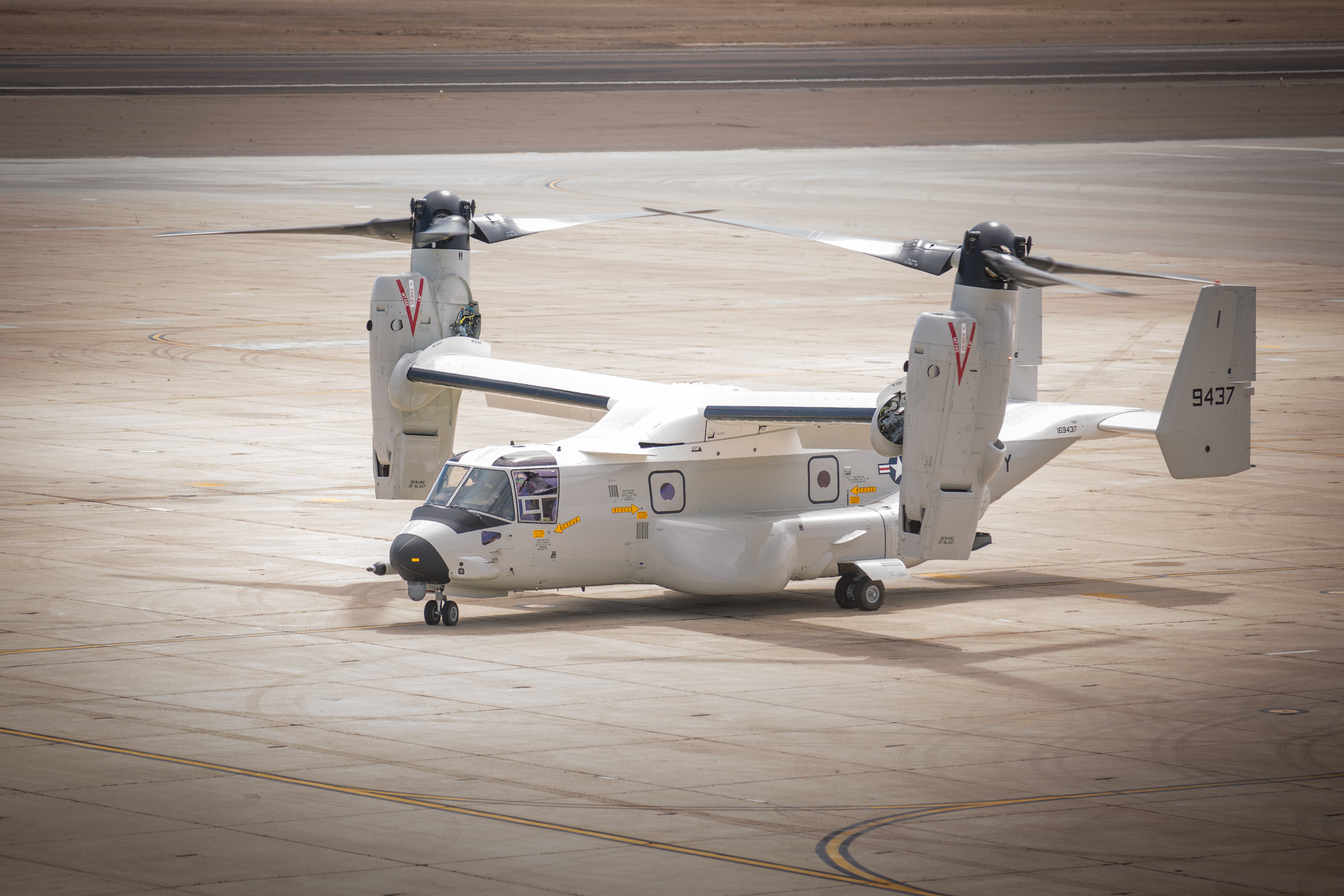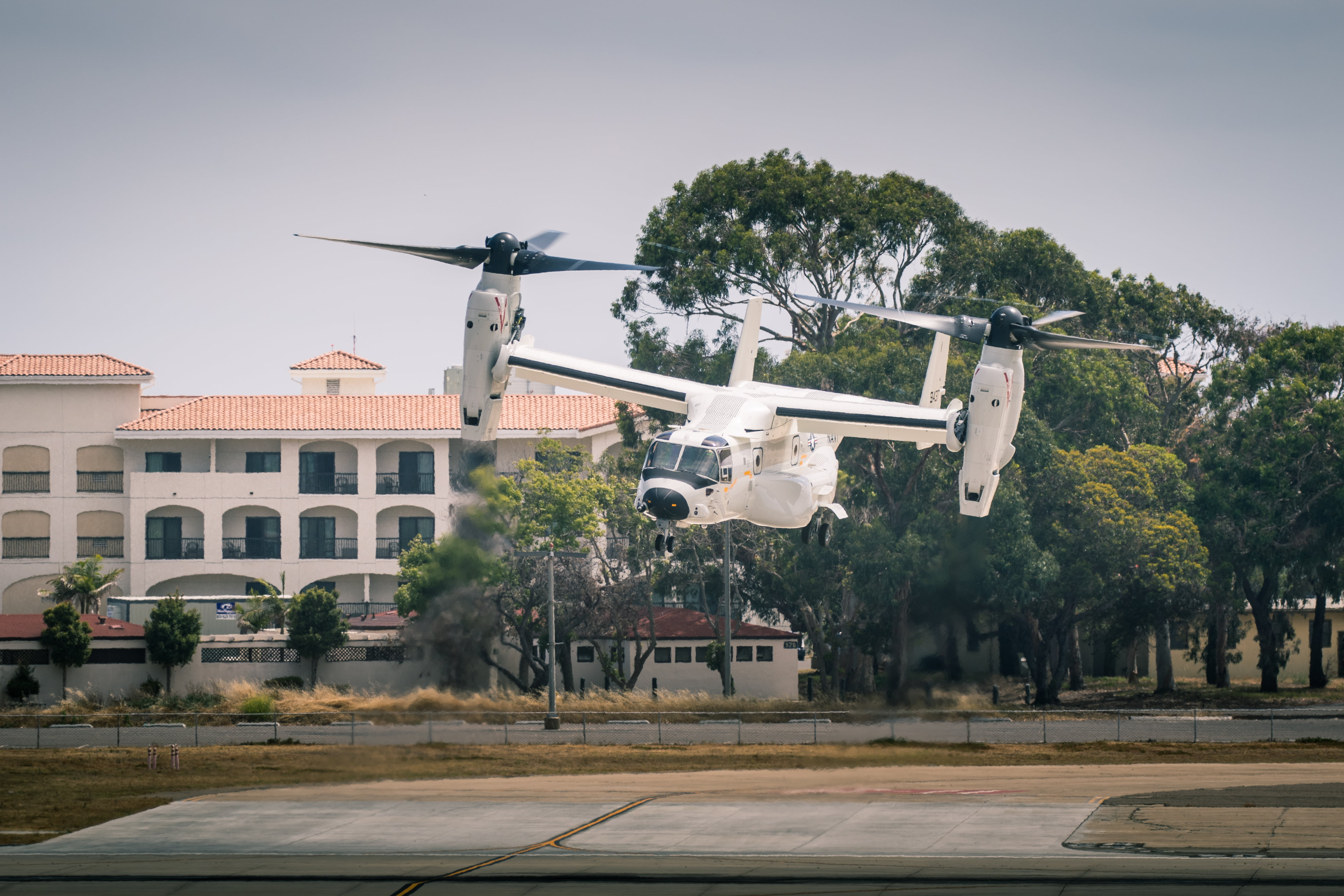By Robbin Laird
In early February of this year, I attended the ceremony unveiling the Navy’s Osprey as the replacement for the C-2 for the logistics support mission.
The Osprey seen in the ceremony was the second Osprey delivered to the Navy, as the first one had been delivered to the Navy at Pax River the week before.
At that ceremony I met Capt. Dewon “Chainsaw” Chaney, the Commander of COMVRMWING (or Fleet Logistics Multi-Mission Wing). As was explained to me by a former C-2 commander, the elevation of the C-2 Command structure to be led by Wing Commander was a major step forward for the force.
As Capt (ret.) Sean McDermott put in an interview with me: “McDermott noted that one of the encouraging signs with the CMV-22B transition is that a new Wing, COMVRMWING has been stood up, and its Commodore who is in charge of the Osprey team now being charged to take over the COD mission.
“This CMV-22 wing should provide a more dedicated voice to implement new ideas for airborne logistics operations as well as exploring how the aircraft could be used to support other missions for the Navy in a distributed maritime environment.”
As the CMV-22B comes to the fleet there are two ways to look at its arrival.
The first is the challenge of ensuring that the logistics mission is effectively met with this new capability. This is a core focus of current efforts of Captain Chaney, as he works the standup of the CMV-22B squadrons.
But there is another piece as well: how will the Navy leverage the coming of the Osprey in the “integratable” air wing?
This I discussed the week before with the Navy Air Boss, Vice Admiral Miller, prior to going to Amarillo Texas and the reveal ceremony.
In that interview, Vice Admiral Miller highlighted how the Navy was looking at the coming of the Osprey.
It is a different aircraft, and the question will be as it operates effectively in its logistics mission, what other contributions might it make to the fleet?
“So how should the Navy operate, modernize, and leverage its Ospreys?
“For Miller, the initial task is to get the Osprey onboard the carrier and integrated with CVW operations.
“But while doing so, it is important to focus on how the Osprey working within the CVW can provide a more integrated force.
“Vice Admiral Miller and his team are looking for the first five-year period in operating the CMV-22 for the Navy to think through the role of the Osprey as a transformative force, rather than simply being a new asset onboard a carrier.
“Hence, one can look at the CMV-22 innovation cluster in the following manner:
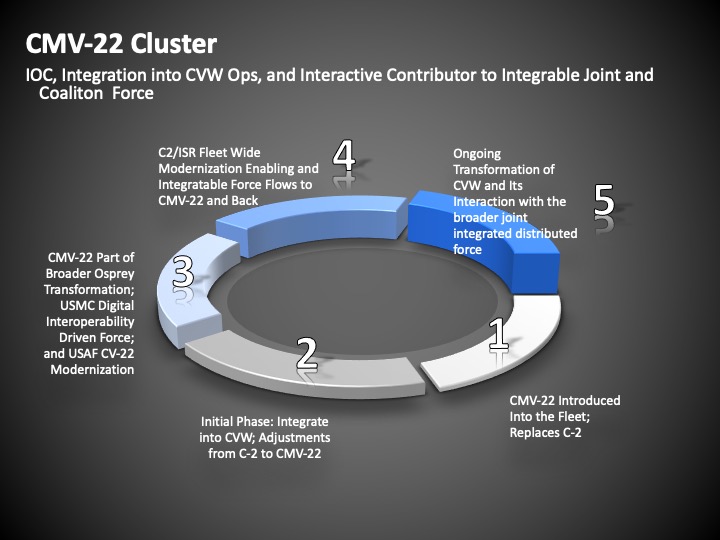
“Such an approach is embedded in the rethink from operating and training an integrated air wing to an integratable air wing.”
When I visited NAWDC (or the Naval Aviation Warfighting Center) recently, one subject which I discussed with the CO of NAWDC, Rear Admiral Brophy was the coming of the CMV-22B.
One thing that should be noted is that the C-2 was never really part of a NAWDC discussion; the CMV-22B clearly is.
According to Rear Admiral Brophy, they will work the TTPs along with Captain Chaney, as it will enter into NAWDC through the rotary wing school in NAWDC, but its ultimate location for cross-platform training, in a command increasingly focused on such training with a kill web focus, will be determined.
After my visit to NAWDC in early July 2020, I went to San Diego and met with the Naval Air Boss on the morning of July 13th and in the afternoon with “Chainsaw.”
During my visit with the Osprey squadron, I had a chance to see the third Osprey on the tarmac, and visit the hangar being used to stand up the squadron.
Obviously, working with the Marines and leveraging their experience allows the Navy to accelerate their efforts to move the new Osprey into the carrier fleet.
And there are synergies and cost savings to be had from such an effort.
For example, in the Navy hangar is a USMC MV-22 airframe which the Navy plans to use in their cargo loading training, which obvious is a cost saver.

One of the issues we discussed during my visit was the challenge of setting up the squadrons.
The first squadron VRM-30 was stood up prior to the creation of the wing and its first aircraft arrived in June 2020.
Captain Chaney noted that there is a two-year timeline to get a fully qualified maintenance technician or officer for the force, so that has been underway. That training has been generated with the Marines in North Carolina, Hawaii, Kuwait, or working side by side with Marines in various locations or in the Bell-Boeing teams at the Maintenance Readiness Team in Miramar.
Captain Chaney then noted that this October, the fleet replacement squadron, VRM-50, will be stood up.
It will take this squadron two years until they will be able to train new pilots.
As he explained: With VRM 30, they need to get pilots ready to go fly and go on deployment.
“Whereas with VRM 50, they have to get pilots and maintainers qualified, but then they also have to figure out how to train other pilots and aircrewman in other words to establish the Navy training cycle for the aircraft.”
He noted that the Navy will approach operating its Osprey in some ways differently from the Marines, but because of the interactive working relationships any learning on the Navy side can be easily be transferred on the Marine side.
“I see it as a very symbiotic relationship between the Marine Corps and us, all under the Department of the Navy.
“Clearly with the Marine Corps having the bulk of the experience right now in MV-22s, I welcome any of their lessons learned and comments about maintaining the airplane, flying the airplane, fighting with the airplane.
“I’m all ears, because I know that my team is still in their infancy.”
But one example of cross learning might be with regard to how the Navy will operate the load outs and off-loading of the aircraft.
They are looking to have a rapid unload capability with new containers for the CMV-22B and Navy experience with the new kit might well prove of interest to the Marine Corps as well.
The counterpart to VRM-30 will be VRM-40 but all three squadrons are under the Wing.
The third squadron will be on the East Coast.
But there clearly is challenge here as the facility to house the third squadron will not be ready at the time the third squadron is being stood up.
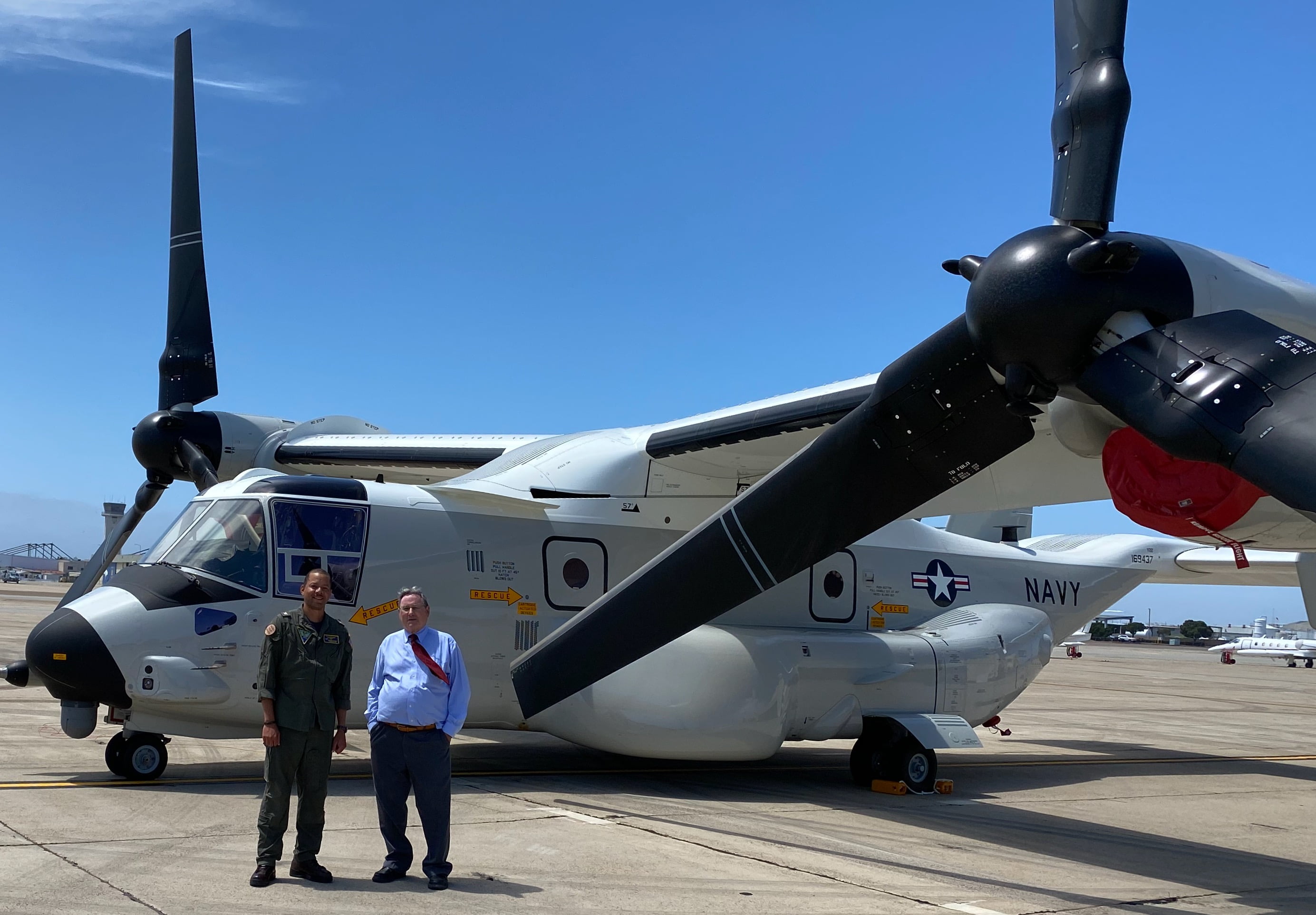
With these challenges, clearly Captain Chaney is focused on the “timeline to get the three squadrons safe for flight.””
And as the Osprey comes to the fleet, building appropriate infrastructure is a key priority facing the Wing in the next few years.
At North Island, San Diego, their first simulator will come next year, and a new hangar is being built and will be ready in 2023. But the East Coast basing solution remains to be resolved.
With regard to the standup, the Wing Commander comes from the rotary wing community; his Deputy from the C-2 community.
The challenge is blending the two into a tiltrotor force which operates at a different altitude from the C-2, can fly night shipboard missions (which the C-2 did not), and rapid, efficient shipboard operations, which has not been the core focus of the USMC and their use of the aircraft.
It is clear that the CMV-22B needs to prepare for carrier operations but equally the carrier community needs to get ready for the coming of CMV-22B.
Captain Chaney is looking to find ways to have lessons learned prior to deployment to shape a more effective initial deployment process as well.
We discussed a coming key event for the CMV-22B squadron, namely working the process of delivering F-35 power module to the carrier.
Both the F-35C and the CMV-22B are scheduled to co-deploy on the USS Carl Vinson in 2021.
And later this Fall, the CMV-22B team will be working the engine carry effort onboard a carrier.
This is a process of lifting the power module to the carrier and working ways to ensure a core competence to do so going forward.
There is a process underway to produce a representative power module to work with in the pre-deployment training phase.
As Captain Chaney put it:” It’s going to be the same weight, the same shape, have all the same attachment points, so that it’ll actually go in the can the way it’s supposed to.”
“There will be a lot of moving parts in the logistics effort to have F-35 engines available for CMV-22Bs to fly them to the ship and then for the ship’s crew to offload the engines and have them available for the F-35s onboard ship.
“The engine manufacturer has created a marinized version of support equipment required and will have it ready for our first deployment.”
Captain Chaney mentioned some cross learning being shaped on North Island itself.
The Chief of Staff for the Air Boss, is Captain McCoy who previously led the F-35 transition in the Navy and the two are discussing lessons learned, to be shaped, or learned from the kind of transition which the Marines have already done with their versions of the two aircraft, but which have their own challenges when adapting to carrier operations as well.
It is obvious that these next three years will be challenging, and I asked “Chainsaw” about those challenges.
“The frustrating thing though, is that it’s just seems like every day, there’s a new challenge.
“There’s a new obstacle.
“There’s something in the way for my team getting from point A to point B.
“Now the other refreshing thing is my leadership is very supportive.
“They’ve been nothing but supportive with issues that I brought to the table.
“The Air Boss has been great to work with. I think he’s been very realistic in his expectations.”
Captain Chaney concluded: “I do believe that the Navy is really going to appreciate the capabilities that the CMV-22 is going to bring to the strike group, and they’re going to want it to do more.”
Editor’s Note: At the February 2020 CMV-22B reveal ceremony, Captain Chaney highlighted the coming of the new capability and what it meant for the US Navy.
What is the status of the CODs?
Every Carrier Air Wing Commander and Carrier CO has received that question numerous times from the Carrier Strike Group Commander while on deployment. And for good reason…
The COD, or Carrier On-board Delivery, aircraft is the only long-range aerial logistics platform providing logistical support for the Carrier Strike Group, ensuring its time sensitive combat capability.
Sure, there are ways to get some items to the carrier but that time lag in most cases is at the cost of readiness for the warfare commander.
The Navy saw the need to replace the aircraft providing this critical capability years ago and embarked on multiple efforts to inform that decision. The Navy selected V-22 as the future COD platform.
The first aircraft is being delivered today (well actually a week ago but who is counting). And our first deployment will be here in a blink of an eye!
But the devil in the details with this particularly accelerated program is making sure that the fleet can man, train, and equip those at the tip of the spear potentially in harm’s way.
As of October, last year as the Wing Commodore, I have the honor, privilege and responsibility, given to me by Vice Admiral Miller, to be the lead for the Navy’s CMV-22 community along with our partners at well into the 2040s. Delivery of this aircraft is a major milestone on the path to initial operational capability in 2021.
The CMV-22 has the capability to internally carry the F-35C engine power module. This capability is a game changer for the Air Wing of the Future and drove the need to match up the F-35C and CMV-22 operational deployments.
The first CMV-22 deployment is now less than a year from initial delivery of N3, which is scheduled for late June of this year.
Its success is key to maintaining combat lethality for the Air Wing of the future and our Navy. CMV-22s will operate from all aircraft carriers providing a significant range increase for operations from the Sea Bases enabling Combatant Commanders to exercise increased flexibility and options for warfare dominance.
If you’re in a fight, it’s always good to have options!
Every month following the first initial deployment, there will be a CMV-22 detachment operating with a US aircraft carrier somewhere in the world….
For a look at the first time an Osprey brought an F-35 engine onboard ship, see the following:
Shaping a New Capability for the Osprey: Delivering the F-35 Engine to the USS Wasp
For the lead interview from my visit to North Island during the July 2020 visit, see the following:
An Update on the Integratable Air Wing: A Discussion with the US Navy’s Air Boss


